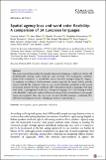Files in this item
Spatial agency bias and word order flexibility : a comparison of 14 European languages
Item metadata
| dc.contributor.author | Suitner, Caterina | |
| dc.contributor.author | Maass, Anne | |
| dc.contributor.author | Navarrete, Eduardo | |
| dc.contributor.author | Formanowicz, Magdalena | |
| dc.contributor.author | Bratanova, Boyka | |
| dc.contributor.author | Cervone, Carmen | |
| dc.contributor.author | Hakoköngäs, Juho Eemeli | |
| dc.contributor.author | Kuppens, Toon | |
| dc.contributor.author | Lipourli, Eleni | |
| dc.contributor.author | Rakić, Tamara | |
| dc.contributor.author | Scatolon, Andrea | |
| dc.contributor.author | Teixeira, Catia P. | |
| dc.contributor.author | Wang, Zhenlan | |
| dc.contributor.author | Sobral, Maria Pedro | |
| dc.contributor.author | Carrier, Antonin | |
| dc.date.accessioned | 2021-03-03T14:30:07Z | |
| dc.date.available | 2021-03-03T14:30:07Z | |
| dc.date.issued | 2021-05-01 | |
| dc.identifier | 273108040 | |
| dc.identifier | a96680cb-78c7-41a2-9f56-03e3effea1aa | |
| dc.identifier | 85100720610 | |
| dc.identifier | 000644869700005 | |
| dc.identifier.citation | Suitner , C , Maass , A , Navarrete , E , Formanowicz , M , Bratanova , B , Cervone , C , Hakoköngäs , J E , Kuppens , T , Lipourli , E , Rakić , T , Scatolon , A , Teixeira , C P , Wang , Z , Sobral , M P & Carrier , A 2021 , ' Spatial agency bias and word order flexibility : a comparison of 14 European languages ' , Applied Psycholinguistics , vol. 42 , no. 3 , pp. 657-671 . https://doi.org/10.1017/S0142716420000831 | en |
| dc.identifier.issn | 0142-7164 | |
| dc.identifier.other | ORCID: /0000-0001-8247-0871/work/90112444 | |
| dc.identifier.uri | https://hdl.handle.net/10023/21548 | |
| dc.description.abstract | The spatial agency bias predicts that people whose native language is rightward written will predominantly envisage action along the same direction. Two mechanisms contribute jointly to this asymmetry: (a) an embodied process related to writing/reading; (b) a linguistic regularity according to which sentence subjects (typically the agent) tend to precede objects (typically the recipient). Here we test a novel hypothesis in relation to the second mechanism, namely, that this asymmetry will be most pronounced in languages with rigid word order. A preregistered study on 14 European languages (n = 420) varying in word order flexibility confirmed a rightward bias in drawings of interactions between two people (agent and recipient). This bias was weaker in more flexible languages, confirming that embodied and linguistic features of language interact in producing it. | |
| dc.format.extent | 15 | |
| dc.format.extent | 1098880 | |
| dc.language.iso | eng | |
| dc.relation.ispartof | Applied Psycholinguistics | en |
| dc.subject | Cross-linguistic | en |
| dc.subject | Word order | en |
| dc.subject | Spatial agency bias | en |
| dc.subject | BF Psychology | en |
| dc.subject | Experimental and Cognitive Psychology | en |
| dc.subject | Language and Linguistics | en |
| dc.subject | Linguistics and Language | en |
| dc.subject | Psychology(all) | en |
| dc.subject | DAS | en |
| dc.subject | MCC | en |
| dc.subject.lcc | BF | en |
| dc.title | Spatial agency bias and word order flexibility : a comparison of 14 European languages | en |
| dc.type | Journal article | en |
| dc.contributor.institution | University of St Andrews. School of Management | en |
| dc.contributor.institution | University of St Andrews. Centre for Research into Equality, Diversity & Inclusion | en |
| dc.identifier.doi | 10.1017/S0142716420000831 | |
| dc.description.status | Peer reviewed | en |
This item appears in the following Collection(s)
Items in the St Andrews Research Repository are protected by copyright, with all rights reserved, unless otherwise indicated.

